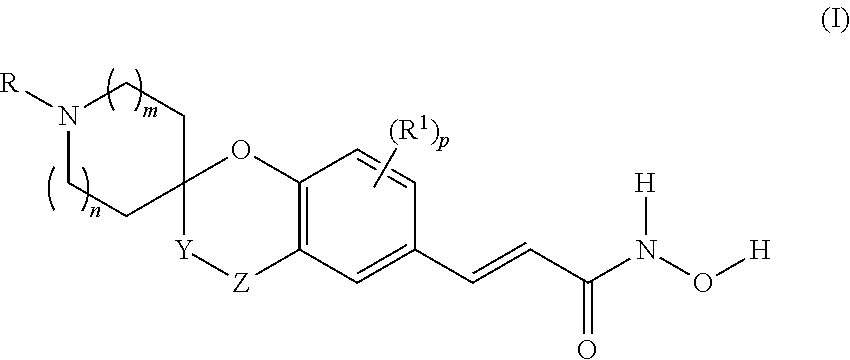Spirocyclic derivatives as histone deacetylase inhibitors
a histone deacetylase inhibitor and spirocyclic derivative technology, applied in the direction of biocide, plant growth regulator, animal husbandry, etc., can solve the problems of poor potency, poor pharmacokinetic properties, limited clinical benefits,
- Summary
- Abstract
- Description
- Claims
- Application Information
AI Technical Summary
Problems solved by technology
Method used
Image
Examples
example 1
(±)-(E)-3-[4-oxo-spiro(chromane-2,3′-pyrrolidine)-6-yl]-N-hydroxy-acrylamide
[0287]
Step A
[0288]HCl 20% aq. (5 ml, 30 mmol) was added to a suspension of (±)-(E)-3-[1-tert-butoxycarbonyl-4-oxo-spiro(chromane-2,3′-pyrrolidine)-6-yl]-acrylic acid methyl ester (Intermediate 1, Step B) (464 mg, 1.2 mmol) in glacial AcOH (5 ml). The mixture was stirred at 85° C. for 3 h and then evaporated under vacuum to give (±)-(E)-3-[4-oxo-spiro(chromane-2,3′-pyrrolidine)-6-yl]-acrylic acid (370 mg) as a white solid (hydrochloride salt).
[0289]Y=quantitative
[0290]LC-MS: (ES+) MH+: 274
[0291]1H NMR (DMSO-d6) δ (ppm): 12.30 (bs, 1H), 9.79 (bs, 1H), 9.67 (bs, 1H), 7.87-8.19 (m, 2H), 7.61 (d, J=15.85 Hz, 1H), 7.08 (d, J=9.39 Hz, 1H), 6.48 (d, J=15.85 Hz, 1H), 3.24-3.66 (m, 4H), 3.21 (d, J=17.02 Hz, 1H), 3.11 (d, J=17.02 Hz, 1H), 2.22-2.43 (m, 1H), 2.10 (dt, J=13.86, 9.94 Hz, 1H).
Step B
[0292]TEA (0.50 ml, 3.6 mmol) was added to the suspension of (±)-(E)-3-[4-oxo-spiro(chromane-2,3′-pyrrolidine)-6-yl]-acrylic a...
example 2
(±)-(E)-3-[1′-Benzyl-4-oxo-spiro(chromane-2,3′-pyrrolidine)-6-yl]-N-hydroxy-acrylamide
[0304]
Step A
[0305]A suspension of (±)-(E)-3-[4-oxo-spiro(chromane-2,3′-pyrrolidine)-6-yl]-acrylic acid methyl ester hydrochloride salt (440 mg, 1.36 mmol, Intermediate 1) in aqueous 10% NaHCO3 solution was extracted with DCM (3×10 ml). The organic phase was dried over Na2SO4 and evaporated. The resulting oil was dissolved in DCM (15 ml), treated with benzaldehyde (0.166 ml, 1.63 mmol) and NaBH(OAc)3 (433 mg, 2.04 mmol), and the resulting clear solution was stirred at RT for 2 h. Water was added to the mixture and the pH was brought to basic conditions with NH3. The mixture was extracted with DCM (3×10 ml). The organic layer was dried, evaporated, and the crude residue was purified by column chromatography (eluent: petroleum ether / EtOAc 7:3) to give (±)-(E)-3-[1′-benzyl-4-oxo-spiro(chromane-2,3′-pyrrolidine)-6-yl]-acrylic acid methyl ester (482 mg) as a light yellow solid.
[0306]Y=94%
[0307]LC-MS: (ES...
example 3
(−)-(E)-3-[1′-Benzyl-4-oxo-spiro(chromane-2,3′-pyrrolidine)-6-yl]-N-hydroxy-acrylamide
[0321]
Step A
[0322]TEA (1.89 ml, 13.6 mmol) was added to solution of (S)-2-(6-methoxynaphthalen-2-yl)propanoic acid (1.57 g, 6.81 mmol) in DCM (80 ml). The mixture was cooled down to 0° C., and EDC (1.95 g, 10.2 mmol) and HOBt (1.38 g, 10.2 mmol) were added. The mixture was stirred at 0° C. for 2 h, then (±)-(E)-3-[4-oxo-spiro(chromane-2,3′-pyrrolidine)-6-yl]-acrylic acid methyl ester hydrochloric salt (Intermediate 1, 2.20 g, 6.81 mmol) previous treated with TEA (0.947 ml, 6.81 mmol) in DCM (20 ml) was added and the mixture was stirred at RT overnight. The solution was washed with aqueous 5% NaHCO3 solution and brine. The organic layer was then dried over Na2SO4 and evaporated. The crude residue was purified by column chromatography (eluent: DCM / i-PrOH 99:1) and the diastereoisomers were separated. The less polar one was re-crystallized from i-PrOH to give (+)-(E)-3-[1-[(S)-2-(6-methoxynaphthalen-2...
PUM
 Login to View More
Login to View More Abstract
Description
Claims
Application Information
 Login to View More
Login to View More - R&D
- Intellectual Property
- Life Sciences
- Materials
- Tech Scout
- Unparalleled Data Quality
- Higher Quality Content
- 60% Fewer Hallucinations
Browse by: Latest US Patents, China's latest patents, Technical Efficacy Thesaurus, Application Domain, Technology Topic, Popular Technical Reports.
© 2025 PatSnap. All rights reserved.Legal|Privacy policy|Modern Slavery Act Transparency Statement|Sitemap|About US| Contact US: help@patsnap.com



